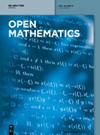求助PDF
{"title":"Hermite-Hadamard-type inequalities for generalized trigonometrically and hyperbolic ρ-convex functions in two dimension","authors":"Silvestru Sever Dragomir, Mohamed Jleli, Bessem Samet","doi":"10.1515/math-2024-0028","DOIUrl":null,"url":null,"abstract":"In this article, we establish Hermite-Hadamard-type inequalities for the two classes of functions <jats:inline-formula> <jats:alternatives> <jats:inline-graphic xmlns:xlink=\"http://www.w3.org/1999/xlink\" xlink:href=\"graphic/j_math-2024-0028_eq_002.png\"/> <m:math xmlns:m=\"http://www.w3.org/1998/Math/MathML\"> <m:msub> <m:mrow> <m:mi>X</m:mi> </m:mrow> <m:mrow> <m:mo>±</m:mo> <m:mi>λ</m:mi> </m:mrow> </m:msub> <m:mrow> <m:mo>(</m:mo> <m:mrow> <m:mi mathvariant=\"normal\">Ω</m:mi> </m:mrow> <m:mo>)</m:mo> </m:mrow> <m:mo>=</m:mo> <m:mrow> <m:mo stretchy=\"false\">{</m:mo> <m:mrow> <m:mi>f</m:mi> <m:mo>∈</m:mo> <m:msup> <m:mrow> <m:mi>C</m:mi> </m:mrow> <m:mrow> <m:mn>2</m:mn> </m:mrow> </m:msup> <m:mrow> <m:mo>(</m:mo> <m:mrow> <m:mi mathvariant=\"normal\">Ω</m:mi> </m:mrow> <m:mo>)</m:mo> </m:mrow> <m:mo>:</m:mo> <m:mi mathvariant=\"normal\">Δ</m:mi> <m:mi>f</m:mi> <m:mo>±</m:mo> <m:mi>λ</m:mi> <m:mi>f</m:mi> <m:mo>≥</m:mo> <m:mn>0</m:mn> </m:mrow> <m:mo stretchy=\"false\">}</m:mo> </m:mrow> </m:math> <jats:tex-math>{X}_{\\pm \\lambda }\\left(\\Omega )=\\{f\\in {C}^{2}\\left(\\Omega ):\\Delta f\\pm \\lambda f\\ge 0\\}</jats:tex-math> </jats:alternatives> </jats:inline-formula>, where <jats:inline-formula> <jats:alternatives> <jats:inline-graphic xmlns:xlink=\"http://www.w3.org/1999/xlink\" xlink:href=\"graphic/j_math-2024-0028_eq_003.png\"/> <m:math xmlns:m=\"http://www.w3.org/1998/Math/MathML\"> <m:mi>λ</m:mi> <m:mo>></m:mo> <m:mn>0</m:mn> </m:math> <jats:tex-math>\\lambda \\gt 0</jats:tex-math> </jats:alternatives> </jats:inline-formula> and <jats:inline-formula> <jats:alternatives> <jats:inline-graphic xmlns:xlink=\"http://www.w3.org/1999/xlink\" xlink:href=\"graphic/j_math-2024-0028_eq_004.png\"/> <m:math xmlns:m=\"http://www.w3.org/1998/Math/MathML\"> <m:mi mathvariant=\"normal\">Ω</m:mi> </m:math> <jats:tex-math>\\Omega </jats:tex-math> </jats:alternatives> </jats:inline-formula> is an open subset of <jats:inline-formula> <jats:alternatives> <jats:inline-graphic xmlns:xlink=\"http://www.w3.org/1999/xlink\" xlink:href=\"graphic/j_math-2024-0028_eq_005.png\"/> <m:math xmlns:m=\"http://www.w3.org/1998/Math/MathML\"> <m:msup> <m:mrow> <m:mi mathvariant=\"double-struck\">R</m:mi> </m:mrow> <m:mrow> <m:mn>2</m:mn> </m:mrow> </m:msup> </m:math> <jats:tex-math>{{\\mathbb{R}}}^{2}</jats:tex-math> </jats:alternatives> </jats:inline-formula>. We also obtain a characterization of the set <jats:inline-formula> <jats:alternatives> <jats:inline-graphic xmlns:xlink=\"http://www.w3.org/1999/xlink\" xlink:href=\"graphic/j_math-2024-0028_eq_006.png\"/> <m:math xmlns:m=\"http://www.w3.org/1998/Math/MathML\"> <m:msub> <m:mrow> <m:mi>X</m:mi> </m:mrow> <m:mrow> <m:mo>−</m:mo> <m:mi>λ</m:mi> </m:mrow> </m:msub> <m:mrow> <m:mo>(</m:mo> <m:mrow> <m:mi mathvariant=\"normal\">Ω</m:mi> </m:mrow> <m:mo>)</m:mo> </m:mrow> </m:math> <jats:tex-math>{X}_{-\\lambda }\\left(\\Omega )</jats:tex-math> </jats:alternatives> </jats:inline-formula>. Notice that in the one-dimensional case, if <jats:inline-formula> <jats:alternatives> <jats:inline-graphic xmlns:xlink=\"http://www.w3.org/1999/xlink\" xlink:href=\"graphic/j_math-2024-0028_eq_007.png\"/> <m:math xmlns:m=\"http://www.w3.org/1998/Math/MathML\"> <m:mi mathvariant=\"normal\">Ω</m:mi> <m:mo>=</m:mo> <m:mi>I</m:mi> </m:math> <jats:tex-math>\\Omega =I</jats:tex-math> </jats:alternatives> </jats:inline-formula> (an open interval of <jats:inline-formula> <jats:alternatives> <jats:inline-graphic xmlns:xlink=\"http://www.w3.org/1999/xlink\" xlink:href=\"graphic/j_math-2024-0028_eq_008.png\"/> <m:math xmlns:m=\"http://www.w3.org/1998/Math/MathML\"> <m:mi mathvariant=\"double-struck\">R</m:mi> </m:math> <jats:tex-math>{\\mathbb{R}}</jats:tex-math> </jats:alternatives> </jats:inline-formula>) and <jats:inline-formula> <jats:alternatives> <jats:inline-graphic xmlns:xlink=\"http://www.w3.org/1999/xlink\" xlink:href=\"graphic/j_math-2024-0028_eq_009.png\"/> <m:math xmlns:m=\"http://www.w3.org/1998/Math/MathML\"> <m:mi>λ</m:mi> <m:mo>=</m:mo> <m:msup> <m:mrow> <m:mi>ρ</m:mi> </m:mrow> <m:mrow> <m:mn>2</m:mn> </m:mrow> </m:msup> </m:math> <jats:tex-math>\\lambda ={\\rho }^{2}</jats:tex-math> </jats:alternatives> </jats:inline-formula>, <jats:inline-formula> <jats:alternatives> <jats:inline-graphic xmlns:xlink=\"http://www.w3.org/1999/xlink\" xlink:href=\"graphic/j_math-2024-0028_eq_010.png\"/> <m:math xmlns:m=\"http://www.w3.org/1998/Math/MathML\"> <m:mi>ρ</m:mi> <m:mo>></m:mo> <m:mn>0</m:mn> </m:math> <jats:tex-math>\\rho \\gt 0</jats:tex-math> </jats:alternatives> </jats:inline-formula>, then <jats:inline-formula> <jats:alternatives> <jats:inline-graphic xmlns:xlink=\"http://www.w3.org/1999/xlink\" xlink:href=\"graphic/j_math-2024-0028_eq_011.png\"/> <m:math xmlns:m=\"http://www.w3.org/1998/Math/MathML\"> <m:msub> <m:mrow> <m:mi>X</m:mi> </m:mrow> <m:mrow> <m:mi>λ</m:mi> </m:mrow> </m:msub> <m:mrow> <m:mo>(</m:mo> <m:mrow> <m:mi mathvariant=\"normal\">Ω</m:mi> </m:mrow> <m:mo>)</m:mo> </m:mrow> </m:math> <jats:tex-math>{X}_{\\lambda }\\left(\\Omega )</jats:tex-math> </jats:alternatives> </jats:inline-formula> (resp. <jats:inline-formula> <jats:alternatives> <jats:inline-graphic xmlns:xlink=\"http://www.w3.org/1999/xlink\" xlink:href=\"graphic/j_math-2024-0028_eq_012.png\"/> <m:math xmlns:m=\"http://www.w3.org/1998/Math/MathML\"> <m:msub> <m:mrow> <m:mi>X</m:mi> </m:mrow> <m:mrow> <m:mo>−</m:mo> <m:mi>λ</m:mi> </m:mrow> </m:msub> <m:mrow> <m:mo>(</m:mo> <m:mrow> <m:mi mathvariant=\"normal\">Ω</m:mi> </m:mrow> <m:mo>)</m:mo> </m:mrow> </m:math> <jats:tex-math>{X}_{-\\lambda }\\left(\\Omega )</jats:tex-math> </jats:alternatives> </jats:inline-formula>) reduces to the class of functions <jats:inline-formula> <jats:alternatives> <jats:inline-graphic xmlns:xlink=\"http://www.w3.org/1999/xlink\" xlink:href=\"graphic/j_math-2024-0028_eq_013.png\"/> <m:math xmlns:m=\"http://www.w3.org/1998/Math/MathML\"> <m:mi>f</m:mi> <m:mo>∈</m:mo> <m:msup> <m:mrow> <m:mi>C</m:mi> </m:mrow> <m:mrow> <m:mn>2</m:mn> </m:mrow> </m:msup> <m:mrow> <m:mo>(</m:mo> <m:mrow> <m:mi>I</m:mi> </m:mrow> <m:mo>)</m:mo> </m:mrow> </m:math> <jats:tex-math>f\\in {C}^{2}\\left(I)</jats:tex-math> </jats:alternatives> </jats:inline-formula> such that <jats:inline-formula> <jats:alternatives> <jats:inline-graphic xmlns:xlink=\"http://www.w3.org/1999/xlink\" xlink:href=\"graphic/j_math-2024-0028_eq_014.png\"/> <m:math xmlns:m=\"http://www.w3.org/1998/Math/MathML\"> <m:mi>f</m:mi> </m:math> <jats:tex-math>f</jats:tex-math> </jats:alternatives> </jats:inline-formula> is trigonometrically <jats:inline-formula> <jats:alternatives> <jats:inline-graphic xmlns:xlink=\"http://www.w3.org/1999/xlink\" xlink:href=\"graphic/j_math-2024-0028_eq_015.png\"/> <m:math xmlns:m=\"http://www.w3.org/1998/Math/MathML\"> <m:mi>ρ</m:mi> </m:math> <jats:tex-math>\\rho </jats:tex-math> </jats:alternatives> </jats:inline-formula>-convex (resp. hyperbolic <jats:inline-formula> <jats:alternatives> <jats:inline-graphic xmlns:xlink=\"http://www.w3.org/1999/xlink\" xlink:href=\"graphic/j_math-2024-0028_eq_016.png\"/> <m:math xmlns:m=\"http://www.w3.org/1998/Math/MathML\"> <m:mi>ρ</m:mi> </m:math> <jats:tex-math>\\rho </jats:tex-math> </jats:alternatives> </jats:inline-formula>-convex) on <jats:inline-formula> <jats:alternatives> <jats:inline-graphic xmlns:xlink=\"http://www.w3.org/1999/xlink\" xlink:href=\"graphic/j_math-2024-0028_eq_017.png\"/> <m:math xmlns:m=\"http://www.w3.org/1998/Math/MathML\"> <m:mi>I</m:mi> </m:math> <jats:tex-math>I</jats:tex-math> </jats:alternatives> </jats:inline-formula>.","PeriodicalId":48713,"journal":{"name":"Open Mathematics","volume":"53 1","pages":""},"PeriodicalIF":0.9000,"publicationDate":"2024-08-02","publicationTypes":"Journal Article","fieldsOfStudy":null,"isOpenAccess":false,"openAccessPdf":"","citationCount":"0","resultStr":null,"platform":"Semanticscholar","paperid":null,"PeriodicalName":"Open Mathematics","FirstCategoryId":"100","ListUrlMain":"https://doi.org/10.1515/math-2024-0028","RegionNum":4,"RegionCategory":"数学","ArticlePicture":[],"TitleCN":null,"AbstractTextCN":null,"PMCID":null,"EPubDate":"","PubModel":"","JCR":"Q1","JCRName":"MATHEMATICS","Score":null,"Total":0}
引用次数: 0
引用
批量引用
二维广义三角函数和双曲ρ凸函数的 Hermite-Hadamard 型不等式
在本文中,我们为两类函数 X ± λ ( Ω ) = { f∈ C 2 ( Ω ) : Δ f ± λ f ≥ 0 } 建立了赫米特-哈达玛式不等式。 {X}_{pm \lambda }\left(\Omega )=\{f\in {C}^{2}\left(\Omega ):\Delta f\pm \lambda f\ge 0\} 其中 λ > 0 (lambda \gt 0)和 Ω Omega 是 R 2 {{mathbb{R}}^{2} 的一个开放子集。我们还可以得到集合 X -λ ( Ω ) {X}_{-\lambda }\left(\Omega ) 的特征。请注意,在一维情况下,如果 Ω = I \Omega =I(R {mathbb{R}} 的一个开放区间)且 λ = ρ 2 \lambda =\{rho }^{2} ,ρ > 0 λ = ρ 2 \lambda =\{rho }^{2}, ρ > 0 λ = ρ 2 \lambda =\{rho }^{2}. ρ > 0 \rho \gt 0 ,那么 X λ ( Ω ) {X}_{\lambda }\left(\Omega ) (resp. X - λ ( Ω ) {X}_{-\lambda }\left(\Omega ) 类函数 f∈ C 2 ( I ) f\in {C}^{2}\left(I),使得 f f 在 I I 上是三角函数 ρ \rho -凸(或者说双曲函数 ρ \rho -凸)。
本文章由计算机程序翻译,如有差异,请以英文原文为准。

 求助内容:
求助内容: 应助结果提醒方式:
应助结果提醒方式:


